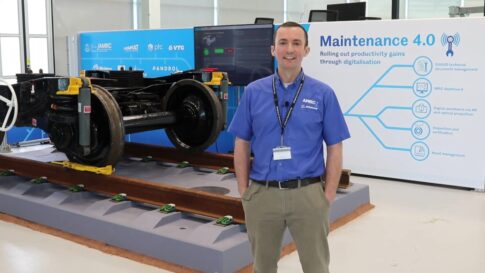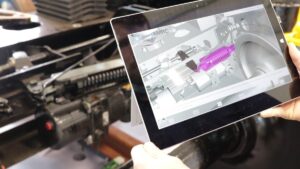| A powerful suite of smart technologies is harnessed to rail maintenance innovations in a new lighthouse demonstrator at the AMRC to drive digital transformation of the rail sector and deliver operational gains The Maintenance 4.0 cell is being developed by engineers at the University of Sheffield Advanced Manufacturing Research Centre (AMRC) at its Factory 2050 facility to shine a light on the range of growing Industry 4.0 technology solutions that can unlock productivity, quality and sustainability improvements for maintenance activities in rail. Horizontal innovation shows the art of the possible for rail Maintenance, Repair and Overhaul (MRO), by bringing AMRC knowledge and expertise learned from aerospace and automotive and applying it to rail. The goal is to inspire visitors and to demonstrate how these technologies can deliver operational gains across rail MRO. It shows how the adoption of digital technologies can be employed in safety critical maintenance operations, adding value to paper-based technical information and using smart technologies like augmented reality, vision inspection and data insights to chart a clear path to industrial digitalisation and the benefits of digitised technical publications, remote assistance and faster skills training. Richard Gardiner, sector lead for rail at the University of Sheffield AMRC, said the AMRC is proud to be building its reputation and prowess in rail, which has a rich heritage in South Yorkshire; Doncaster played a key role in the early days of steam – it’s where The Flying Scotsman and Mallard locomotives were built – and is today home to a cluster of world-class rail businesses. “We understand how important rail is to the wider economy, contributing £36 billion annually,” says Gardiner. “The UK’s rail network is undergoing the biggest programme of modernisation since Victorian times – tens of billions are being invested in infrastructure and capacity improvements including here in South Yorkshire through HS2 and Northern Powerhouse Rail initiatives – so it’s crucial we build our knowledge in the sector and nurture relationships with rail SMEs and OEMs to further MRO technologies that can improve operational efficiencies and ultimately help them remain competitive.” Gardiner says the cell’s benefits are four fold: it will enhance quality and reduce life cycle costs by harnessing the power of data; support sustainability by significantly reducing wasted resources; create step changes in productivity by facilitating smart resource allocation; and boost the UK economy by removing barriers to digital adoption. The project not only develops the AMRC’s understanding and capability in the rail industry but, crucially, it will inspire the rail supply chain with the confidence they need to invest in innovative solutions. Gardiner added: “We will create a platform that can be used by our rail partners to develop systems and de-risk the adoption of new digital tools and processes. The goal is to minimise barriers to digital adoption in rail maintenance by using readily available consumer software and off-the-shelf hardware, making the cell accessible to companies of all shapes, sizes, sectors and budget. “It will show that the University of Sheffield AMRC is the go-to place for companies wanting to access smart digital solutions that can help them improve productivity, quality and contribute to their sustainability efforts.” Augmented reality (AR), which played a vital role in retraining 3,500 automotive and aerospace operators to build life-saving devices for Ventilator Challenge UK, is one of the stars of the smart-assisted maintenance demonstrator. Other features include optical projection, S1000D technical document management, a user-friendly but data-packed digital MRO dashboard, camera inspection and verification, and asset management tracking systems. Maintenance 4.0 is funded by the High Value Manufacturing (HVM) Catapult and developed with support from technology company PTC, complex critical content experts GPSL, global freight and rail provider Wabtec Corporation, rail fastenings manufacturer Pandrol, rail logistics company VTG and digital visualisation content creators, Bloc Digital. Gordon Innes, of Wabtec, said: “As a leader of a team of remotely deployed field service operatives it’s important to me that we look to harness the power of technology to provide best possible support to the operatives in the field ensuring standards are being met and safety is assured. “I have a keen interest in the overlap between maintenance standards and the platforms for enhanced maintenance service delivery; incorporating technology such as AR into maintenance documentation is a key area of interest especially as we look to introduce new and modified products into the rail market. “Tracking material usage automatically as well as machine vision systems for inspection are key areas of interest. The MRO technology demonstrator cell at the AMRC represents an opportunity for Wabtec to continue to explore these technologies while supporting the industry, understanding the art of the possible as well as any practical limitations.” The art of the possible was premiered to a captive audience of global leaders in aerospace, defence and space at the TDW-Live show on November 18, and the cell is expected to be up-and-running at the Factory 2050 facility by early next year. Arthur Kershaw, senior project engineer at the AMRC, says the technologies powering the demonstrator have potential to unlock big benefits for both smaller businesses and OEMs looking to advance their MRO capabilities and improve operational efficiencies. “A key feature is the operator guidance, empowering those carrying out a task with up-to-date, in-situ information. The live digital dashboard that will take data from various sources and present it in a way that enables supervisors and managers to capture and solve problems before they become an issue. “An asset tracking system enables businesses to benefit from seeing the movement of high value items – detecting who has taken or replaced a component, what component, and when. This allows the management of unsecured materials that may have previously been difficult to quantify. “It will also have camera verification of certain processes, projected in-situ. We’ve refined it to just highlight the manual brake state for this demonstrator, but the methodology developed could be rolled out to any component with a detectable state, through optical recognition or other sensor output.” PTC’s Vuforia software technology will underpin the AR experiences that will be seen in the demonstrator. Paul Haimes, vice president for field engineering at PTC, said the immersive technology is already being used to address manufacturing challenges with measurable value, including remote worker assistance, knowledge capture for training and digitised standardised operating procedures. “That’s the focus of the project at the AMRC for us – the ability to augment the users’ view with CAD data and information that then shows how to assemble, disassemble or change over equipment, whatever it might be; those types of activities lend themselves very neatly to the augmented reality space,” said Paul. “With remote assistance we’re seeing 40% fewer physical visits which has a huge impact on a company’s costs for maintaining products; for digital standard operating procedures we’re seeing individuals work faster and more consistently with training times reduced between 20% to 40% and up to a 20% reduction in errors that individuals are making. “Five years ago a lot of companies were exploring whether AR works and how it adds value. Today, we see bigger companies move from a more general level of assessing technologies, such as proof of technology and proof of value, to scaling AR to suit their requirements.” Notes to editors IMG 1 Richard Gardiner, AMRC rail sector lead, and the new Maintenance 4.0 demonstrator at the University of Sheffield AMRC Factory 2050. IMG 2 Augmented reality is one of the star technologies deployed in the demonstrator which aims to drive up digital capabilities for the rail maintenance sector. Media contact: Katia Harston, AMRC Communications Manager, k.harston@amrc.co.uk About the AMRC The University of Sheffield Advanced Manufacturing Research Centre (AMRC) is a world-class centre for research into advanced manufacturing technologies used in the aerospace, automotive, medical and other high-value manufacturing sectors. The AMRC has a global reputation for helping companies overcome manufacturing problems and is a model for collaborative research involving universities, academics and industry worldwide. Combining state of the art technologies with the AMRC’s expertise in design and prototyping, machining, casting, welding, additive manufacturing, composites, robotics and automation, digital manufacturing and structural testing, has created a manufacturing resource far beyond anything previously available in the UK. The AMRC is a member of the High Value Manufacturing Catapult, a consortium of leading manufacturing and process research centres, backed by the UK’s innovation agency, Innovate UK. www.amrc.co.uk |

